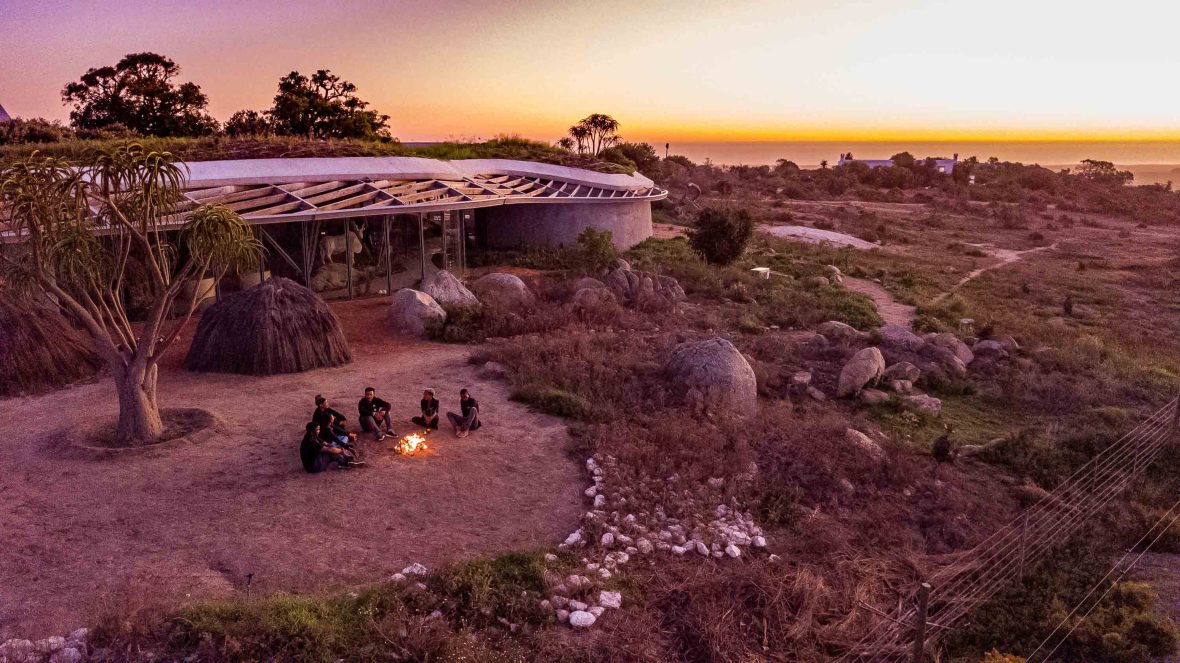
From gin infused with elephant dung and dishes inspired by invasive plants, Africa’s safari cuisine is changing—and there’s a new league of chefs stirring things up.


From gin infused with elephant dung and dishes inspired by invasive plants, Africa’s safari cuisine is changing—and there’s a new league of chefs stirring things up.
On an African safari, wonderful things occur, apparently by magic. Just as your vehicle approaches a waterhole, elephants raise their mighty trunks to sniff the air, as if to greet you. Lionesses pad out of the shade, their cubs tumbling around them. And often, towards the end of a fruitful drive, you’ll turn a corner to discover a camp table set up under a spreading kigelia tree, with bush chefs standing by.
Such happy surprises may indeed seem miraculous, but in truth, there’s no wizardry behind them: Safari teams plan and anticipate unforgettable events through hard work, experience and skill. Top guides deploy their patience and knowledge to find the animals you’d most like to see. Meanwhile, chefs prepare creations that wouldn’t be out of place in a celebrated city restaurant. But how do they manage this, given the often-isolated locations?

It’s no mean feat. Many of the continent’s best camps and lodges are in remote, off-grid locations, where the facilities are, by necessity, ad hoc. Keen to spoil their guests with hearty meat-based barbecues and elaborate but familiar restaurant-style fare, they generally rely on international-style recipes that use trucked-in supplies.
But increasingly, as sustainability and an enhanced sense of place move up the agenda, the most imaginative safari chefs are throwing out those menus created decades ago and rethinking how they source ingredients.
After a thrilling drive through South Africa’s Kapama Reserve, I find myself on the terrace at Jabulani, tucking into a healthy, high-protein vegan salad with local beans, nuts, seeds and an herb dressing. Best of all, it’s been prepared specifically for me.
And it’s with a clear conscience—the kitchen uses local ingredients and homegrown herbs, and generates minimal waste. “To make sure we rarely end up with leftover dishes, we present the day’s menu to each table in person, inviting feedback,” says executive chef Alex van As. “That’s when the fun starts: We carefully tailor meals to each guest’s liking.”
Even the sundowners—a safari essential—have a sustainable twist. South Africa’s Ibhu distillery infuses the house spirit, JabuGin, with botanicals such as juniper and angelica extracted from elephant dung, the theory being that elephants only eat the tastiest and healthiest plants. Guests who buy a bottle of JabuGin as a souvenir also contribute to HERD, the elephant orphanage the camp supports.
“Millet—we get all sorts here in East Africa and it’s full of goodness. It can be sprouted, ground into flour and even popped. Tamarind is sour and sweet; adding it to a Swahili curry makes you want to have another mouthful immediately. Baobab is great in smoothies and overnight oats. Moringa pulled straight off the branch into a pan with olive oil, is the tastiest green. I could go on and on. Africa is a Garden of Eden of natural, wholesome foods.”
- Nicky Bryden, exec chef Elewana
JabuGin is by no means the only African tipple with a conservation message. In South Africa’s Western Cape, several distilleries have created gin scented with fynbos plants, unique to the Cape Floral Kingdom, a precious, endangered biome that’s more biodiverse than the Amazon rainforest. Meanwhile, in Tanzania, Sayari Camp in the Serengeti serves lager from its own bush microbrewery. It’s entirely solar-powered—an African first.
I arrive in Kenya’s Loisaba Conservancy just in time to head into the tawny hills for a late afternoon drive. We’re looking for leopards, scanning the lengthening shadows for a flick of a tail or a flash of a rosetta coat.
Suddenly, we spot one: A magnificent male, reclining on a kopje (small hill) in a manner I’ve never seen before. Sprawling prickly pear cacti with bulbous red fruit surround it and, surprisingly, it appears oblivious to the spikes. Perhaps the shade makes the discomfort worthwhile.
“The cacti are opuntia, an invasive species,” says Brown Lengalai, my guide. “Here in Laikipia County, they’ve triggered a cascade effect in the ecosystem. So we’re having to dig them up and destroy them manually.”

I’m staying at one of East African boutique safari specialist Elewana’s recent openings, Loisaba Lodo Springs, a luxury camp with sleek, contemporary lines and elegantly upcycled Edwardian furniture. When I return, I’m greeted with a vitamin-C-boosting, antioxidant-packed prickly pear fruit cocktail, and among the delicate, tapas-style dishes on the menu—many of them vegetarian—I spot a delicious-sounding cactus sorbet.
“It’s our way of turning a negative into a positive, prompting mealtime conversations about conservation imperatives,” says Nicky Bryden, Elewana’s executive chef. Today, many safari chefs are increasingly aware of the health benefits and environmental impact of certain African foods, the best of which are predominantly vegetarian.
“Millet—we get all sorts here in East Africa and it’s full of goodness. It can be sprouted, ground into flour, and even popped,” adds Bryden. “ Tamarind is sour and sweet; adding it to a Swahili curry makes you want to have another mouthful immediately. Baobab is great in smoothies and overnight oats. Moringa, pulled straight off the branch into a pan with olive oil, is the tastiest green. I could go on and on. Africa is a Garden of Eden of natural, wholesome foods.”
By using local ingredients imaginatively, safari chefs aren’t just making safaris more sustainable; they’re also offering guests a dining experience they’d never have elsewhere.
At !Khwa Ttu in South Africa’s Western Cape, a rural reserve and heritage center celebrating San hunter-gatherer traditions, the restaurant serves ‘decolonized’ cuisine, replacing European-style standards with dishes that draw on indigenous African culture.
Instead of asparagus, head chef Werlise Rautenbach offers wild veldkool, and instead of making houmous from chickpeas, she uses heerboon beans, a heritage variety. Main courses include kelp noodles with grilled aubergine. “We’re on a journey to explore San food culture”, says Werlise. “We have an incredible body of knowledge of indigenous plants to draw upon.”
Wolwedans, a collection of beautiful lodges set among the dunes in Namibia’s remote NamibRand Reserve, offers guests something rare—a glimpse behind the scenes. During my stay, I wander around organic kitchen gardens where green fingers are literally making the desert bloom.
“Our environmental needs, such as food, water, energy and waste management, are inter-connected. It’s up to us to control them all consciously. We can’t just be a leaf in the wind,” says owner Stephan Bruckner.
“Too often, safari chefs treat plant-based eaters like second-class citizens, saying ‘Tonight we have lamb, but for you two sitting over there who don’t eat meat, you’re getting a salad,’ or that sort of thing. I think that cooking and serving a great vegan meal takes a lot more effort, thought and creativity. Many are not prepared to invest in that. But in a good chef’s hands it can be an amazing experience for all five senses.”
- Dereck Joubert, Great Plains
Wolwedans staff grew up in a culture of caring about healthy, homegrown ingredients. Many are recruited as school-leavers from economically deprived rural areas, and receive all their culinary training on site. Their vegetable plots and herb beds are prettily laid out; even the composting areas, wormery and pigsty are immaculately tidy.
“I strongly believe it’s worth spending a little extra on making things beautiful as well as functional,” says Bruckner. “It increases our happiness capital.”
Around 50 miles north of Wolwedans, the recently refurbished Little Kulala safari camp offers immersive, mindful dining experiences, with guests choosing to help prepare dishes using ingredients such as mogau oshi (wild spinach), wambu (kidney beans) and dates. African tapas by starlight are a speciality.
Many safari lodges have a time-honored tradition of including farmed game such as eland and impala in their menus. For those who have traveled to Africa’s safari heartlands to see wildlife in the wild, this can jar. But for several years, luxury conservation safari company Great Plains has been normalizing vegan fare by championing high-end locally sourced plant-based meals featuring a rainbow of fruit and vegetables from Africa’s bountiful shambas.
“Too often, safari chefs treat plant-based eaters like second-class citizens, saying ‘Tonight we have lamb, but for you two sitting over there who don’t eat meat, you’re getting a salad,’ or that sort of thing,” says founder Dereck Joubert, himself a vegan. “I think that cooking and serving a great vegan meal takes a lot more effort, thought and creativity. Many are not prepared to invest in that. But in a good chef’s hands it can be an amazing experience for all five senses.”

Elsewhere, chefs are rediscovering the most down-to-earth African ingredients imaginable. When I arrive at The Boma, a high-spirited African-themed dining and entertainment venue in Mosi-oa-Tunya (Victoria Falls), Zimbabwe, tourists are piling their plates high with warthog, kudu and ostrich kebabs, as they do every night. But this old-school braai (barbecue) also includes a heritage superfood; sautéed emperor moth larvae, better known as mopane worms. Rather like biltong, they’re chewy and earthy.
“We give a certificate to each person who eats one for the first time, and we issue more than 250 certificates each month,” says head chef Gerald Kapesa. While it takes courage for the average European or American to bite into a cooked caterpillar, for rural Zimbabweans, frying up mopane worms is as normal as chucking prawns on the barbecue.
Given that nutritionists argue that alternative protein sources could help solve world hunger and climate change, they’re ahead of the curve at The Boma. Larvae can contain twice as much protein by weight as rump steak, making them a great alternative to farmed meat. Of all the ingredients re-shaping safari cuisine, perhaps this—the humble mopane worm—may end up being the most useful of all.
***
Adventure.com strives to be a low-emissions publication, and we are working to reduce our carbon emissions where possible. Emissions generated by the movements of our staff and contributors are carbon offset through our parent company, Intrepid. You can visit our sustainability page and read our Contributor Impact Guidelines for more information. While we take our commitment to people and planet seriously, we acknowledge that we still have plenty of work to do, and we welcome all feedback and suggestions from our readers. You can contact us any time at hello@adventure.com. Please allow up to one week for a response.

Based in Brighton, UK, Emma Gregg is an award-winning travel journalist who has visited all seven continents. Of the seven, it’s Africa that keeps calling her back. She specializes in responsible tourism, writing extensively about sustainable travel including eco-friendly adventures and low-carbon, flight-free trips. She has also interviewed some of the leading conservationists of our age.






Can't find what you're looking for? Try using these tags: